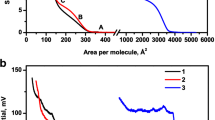Abstract
The morphology on collapsed monolayers at the air-water interface has been studied using phase contrast microscopy. It is found that the transition from randomly distributed to quasi-one dimensional crack pattern takes place, depending on the pH value of the subphase and the presence of specific divalent metal ions. In these macroscopic patterns, the former exhibits a surface roughening due to a monolayer buckling while the latter becomes more smooth and uniform. The occurrence of the former is instantaneous and the latter follows a slow dynamics, i.e., the crack propagation in monolayers occurs with a delay for crack nucleation. Thus the change of pattern indicates the existence of a dynamic transition. The transition is discussed with the scenario of a crack instability in brittle materials. The changes of viscous nature and of ion binding, and the compression direction probably operate for the observed behavior effectively.
Similar content being viewed by others
Author information
Authors and Affiliations
Corresponding author
Rights and permissions
About this article
Cite this article
Hatta, E., Suzuki, D. & Nagao, J. Morphology transition and slow dynamics in the collapse of amphiphilic monolayers at the air-water interface. Eur. Phys. J. B 11, 609–614 (1999). https://doi.org/10.1007/s100510051188
Received:
Published:
Issue Date:
DOI: https://doi.org/10.1007/s100510051188



